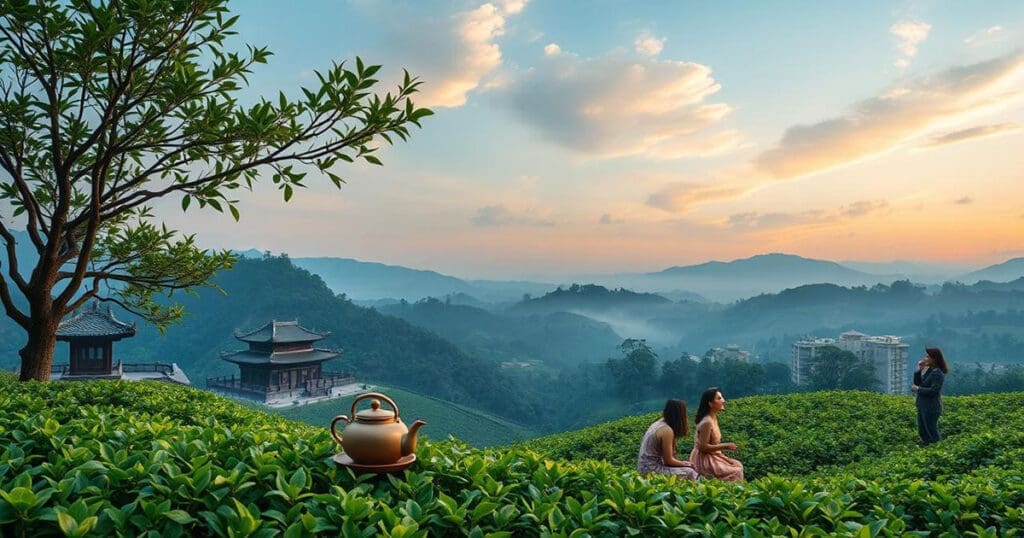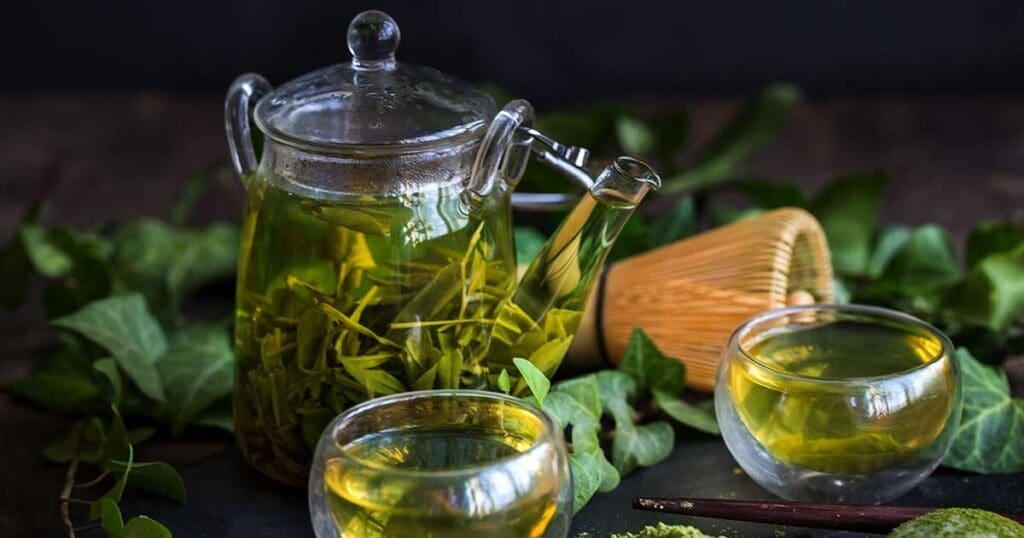We're starting a journey through tea's rich history, from China to today. Tea's story spans thousands of years, from a medicinal drink to a global favorite. We'll see how Chinese tea history has shaped the world.
Tea's journey from a Chinese tradition to a global drink is fascinating. We'll look at key moments that changed the tea industry. These moments include tea's origins and its spread worldwide. Tea's history is a mix of culture, trade, and politics.
Our exploration of tea will cover many topics. We'll learn about tea's role in Chinese culture and the modern tea trade. We aim to give a detailed and engaging look at tea's history. By understanding tea's origins and evolution, we can appreciate its complex and intriguing world.
Key Takeaways
- We'll explore the rich history of tea, from its origins in China to its current status as a global beverage.
- The tea history is a complex and captivating tale that involves the intersection of culture, trade, and politics.
- Chinese tea history has had a significant impact on the world, shaping the tea industry into what it is today.
- The origins of tea are rooted in ancient China, where it was first consumed as a medicinal drink.
- As we dive into the world of tea, we'll discover the significance of tea history and its relevance to modern times.
- The tea industry has undergone significant transformations over the years, driven by changes in culture, trade, and politics.
The History of Tea: From Ancient China to Modern Times
Exploring the history of tea takes us on a journey from ancient China to modern times. We see how tea has evolved and its role in different cultures. Tea's roots in Chinese history go back thousands of years.
Looking at traditional tea practices gives us a glimpse into the past. These practices involved hard work in growing and processing tea leaves. This made tea a precious item.
The Legend of Shennong
Legend says Shennong, a Chinese emperor from over 4,000 years ago, found tea. He accidentally discovered its refreshing taste when tea leaves fell into boiling water.
Early Tea Cultivation Methods
Early tea farming was simple and hard work. Tea plants were grown in far-off places. Leaves were picked by hand, making tea production long and tough.
First Written Records of Tea
The first written records of tea show its early use and trade. These records show tea was valued for its refreshing and medicinal qualities. This made tea even more important in Chinese culture.
The Sacred Leaf: Tea's Role in Ancient Chinese Society
Exploring tea culture shows us tea's big role in ancient China. It was more than just a drink. Tea was at the heart of their culture, with special rituals like the tea ceremony. These ceremonies showed respect, harmony, and a quest for spiritual growth.
In Chinese tea history, tea touched many parts of society. It influenced art, literature, and philosophy. Here's how tea made a mark:
- Tea brought people together, creating a sense of community during the tea ceremony.
- Tea inspired Chinese art, with themes and motifs in paintings and ceramics.
- Tea was a favorite topic in Chinese poetry and stories.
Looking into tea's role in ancient China, we see tea culture is rich and complex. It has deep roots in Chinese tea history. Tea is still a big part of Chinese identity and culture.
Studying tea's role in ancient China helps us understand tea culture better. It shows us why tea is still important today. As we learn more about tea, we'll see how the tea ceremony and Chinese tea history are connected.
The Art of Tea Processing Through the Ages
Exploring the world of tea reveals the evolution of tea processing. The tea trade has greatly influenced these methods, which have evolved over centuries. Techniques like hand-rolling and sun-drying are still used today to highlight the unique qualities of different teas.
Regional differences in tea production have led to a wide variety of teas. From China's rolling hills to Japan's lush gardens, each area has its own tea-making traditions. This diversity creates a rich mix of flavors and aromas, each telling a story of its origins and the traditional practices that shaped it.
Traditional Processing Methods
- Hand-rolling: a labor-intensive process that requires great skill and patience
- Sun-drying: a natural method that helps preserve the tea's delicate flavor and aroma
- Withering: a process that removes excess moisture from the tea leaves, preparing them for further processing

Regional Variations in Tea Production
The evolution of tea has been shaped by regional differences in production. Different climates and soils have led to unique tea varieties. As the tea trade expands, it's crucial to value and preserve these traditional practices for future generations.
| Region | Tea Variety | Processing Method |
|---|---|---|
| China | Green Tea | Hand-rolling and sun-drying |
| Japan | Matcha | Stone-grinding and sun-drying |
| India | Assam Tea | Withering and machine-drying |
Tea's Journey Along the Silk Road
Exploring tea history reveals how tea trade thrived on the Silk Road. This network of ancient routes helped spread tea from China to the world. It greatly influenced global tea consumption.
We'll trace tea's path as it was traded and enjoyed in various places. This shows how the Silk Road spread tea globally.
The Silk Road was key in cultural exchange. It allowed different cultures to adopt tea drinking. This exchange brought new flavors and brewing methods, shaping local traditions.
Tea became a vital part of the tea trade along the Silk Road. Merchants and traders exchanged goods and stories.
- India, where tea became a staple in local cuisine
- Persia, where tea was traded for spices and other valuable commodities
- Arabia, where tea influenced local coffee culture
These places, among others, enriched tea history and global tea consumption. As we learn more about tea, we'll see the Silk Road's role in tea trade and cultural exchange.
The Birth of Tea Culture Beyond China
Tea spread beyond China, creating unique cultures in different countries. We'll look at Japan, Britain, and Russia's tea traditions. Each has its own customs and practices, showing the diversity of global tea consumption.
In Japan, the tea ceremony is a formal ritual. In Britain, afternoon tea is a big part of social life. Russia loves strong, sweet tea in small cups.
Japanese Tea Traditions
Japan's tea culture is simple yet elegant. The tea ceremony is a ritual where green tea is served. It's about the ceremony, nature, and the bond between host and guests.
British Tea Culture
Tea is a big deal in Britain. Afternoon tea is a tradition with sweet and savory treats. It's seen as luxurious and enjoyed by many.
Russian Tea Customs
Russia loves strong, sweet tea in small cups. Tea is key in Russian culture, enjoyed at gatherings and special times. The traditional tea set is beautiful, with delicate cups and intricate designs.
The world's tea culture shows the richness of global tea consumption. From Japan's tea ceremony to Britain's afternoon tea, and Russia's tea, each country has its own way. Tea brings people together, creating community and connection.
| Country | Tea Tradition | Description |
|---|---|---|
| Japan | Tea Ceremony | A highly ritualized and formalized ceremony in which green tea is prepared and served to guests in a specially designed room. |
| Britain | Afternoon Tea | A popular tradition where tea is served with a variety of sweet and savory treats. |
| Russia | Tea Customs | A unique tradition where strong, sweet tea is served in small cups, often at social gatherings and special occasions. |
Revolutionary Moments in Tea Trade History
There have been many important events in the tea trade that have changed the industry. The evolution of tea has seen many changes, including revolutions and cultural exchanges. These have all played a part in how tea is enjoyed around the world.
Some key moments in tea trade history include:
- The establishment of the East India Company, which played a significant role in the tea trade between Europe and Asia.
- The Boston Tea Party, a protest against British taxation that impacted the evolution of tea in America.
- Trade agreements and cultural exchanges that have contributed to the growth of global tea consumption.
These events have shaped the tea trade and how we enjoy tea today. Looking at the evolution of tea helps us understand the challenges the industry has faced. These challenges have helped the industry grow, affecting global tea consumption.

By knowing about these historical events, we can see how important tea is in our lives. The tea trade keeps changing, with new trends and innovations. These changes are shaping the evolution of tea and global tea consumption every day.
Tea's Impact on Global Economics and Politics
Tea's influence goes beyond just being a tasty drink. It has shaped global economics and politics. The tea trade has been key in international relations. From the East India Company to today, tea has driven global commerce.
The tea history shows how tea has affected global economics. Tea was a valuable commodity. The East India Company's control over tea trade greatly influenced the global economy. Tea became a major player in international trade.
Some key events show tea's impact on global economics and politics include:
- The Boston Tea Party, a protest against British taxes and colonial rule
- The East India Company's role in shaping the global tea trade
- Modern tea trade relations, influenced by globalization and trade agreements
Tea's influence on global economics and politics is vast and complex. From the tea trade's early days to now, tea has shaped international relations and global commerce.
The Modern Tea Renaissance
We are seeing a big change in the evolution of tea. This change comes from what people want and value more today. Now, there's a big push for top-notch, unique, and eco-friendly tea.
The specialty tea market is growing fast. This means more people can try teas from all over the world. Tea bars and cafes are also becoming more popular. They offer a place for people to enjoy tea and learn about its tea culture.
As global tea consumption keeps going up, the tea industry is getting creative. Some big trends include:
- Sustainable tea production practices
- Unique and exotic tea blends
- Health-focused tea products
The modern tea movement is about more than just tea. It's about the experience and the community around it. As we dive into the world of tea, we're building a sense of connection and shared love among tea lovers.
Conclusion: Tea's Enduring Legacy in Contemporary Society
Tea's history is fascinating, and it's still loved today. It started in China and Japan and now is enjoyed worldwide. Tea is valued for its cultural importance, health perks, and the joy it brings to people.
Tea lovers around the globe are diving into the world of tea. They're learning about different teas and how to make them. Tea ceremonies, tea time, and tea houses are just a few ways tea brings people together.
Tea's lasting impact shows its universal appeal. It connects people across cultures and places. Let's celebrate tea's heritage and see how it will continue to make our lives better.
Disclaimer:
Some of the links on this site are affiliate links, which means I may earn a small commission if you make a purchase through them, at no additional cost to you. Thank you for supporting Brew Sip Repeat!




Facebook Comments